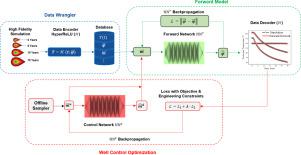当前位置:
X-MOL 学术
›
Appl. Energy
›
论文详情
Our official English website, www.x-mol.net, welcomes your feedback! (Note: you will need to create a separate account there.)
Physics-informed machine learning for noniterative optimization in geothermal energy recovery
Applied Energy ( IF 11.2 ) Pub Date : 2024-04-17 , DOI: 10.1016/j.apenergy.2024.123179 Bicheng Yan , Manojkumar Gudala , Hussein Hoteit , Shuyu Sun , Wendong Wang , Liangliang Jiang
Applied Energy ( IF 11.2 ) Pub Date : 2024-04-17 , DOI: 10.1016/j.apenergy.2024.123179 Bicheng Yan , Manojkumar Gudala , Hussein Hoteit , Shuyu Sun , Wendong Wang , Liangliang Jiang

|
Geothermal energy is clean, renewable, and cost-effective and its efficient recovery management mandates optimizing engineering parameters while considering the underpinning physics, typically achieved through computationally intensive simulators. This study proposes a novel physics-informed machine learning (PIML) framework for geothermal reservoir optimization, integrating a data wrangler to process high-fidelity simulations, a forward network for forward predictions, and a control network to optimize engineering decision parameters while maximizing the objective function and satisfying various engineering constraints. The PIML incorporates an improved Hyperbolic-ReLU (HyperReLU) model to predict the produced geothermal fluid temperature robustly. The forward model uses a neural network to predict hyper-parameters of HyperReLU from reservoir model input and estimates the produced fluid temperature and energy. Further, the control network is trained with labels automatically generated by the forward model. During prediction, it can infer optimum decision parameters noniteratively by inputting uncertain reservoir parameters, ensuring it maximizes the objective function. Numerical experiments reveal that the HyperReLU enhances long-term predictive stability, and the forward network can achieve predictions of the produced temperature and energy within errors of and , respectively. We examine PIML to control the produced temperature drops or maximize the total energy recovery. Compared to the differential evolution (DE) optimizer, PIML closely matches DE with a 53.7% increase in total energy while running 5,465 times faster than DE. Moreover, PIML presents great efficiency and accuracy and is scalable for field-scale geothermal well-control design and other similar optimization problems.
中文翻译:

基于物理的机器学习,用于地热能回收的非迭代优化
地热能是清洁、可再生且具有成本效益的能源,其高效的回收管理要求优化工程参数,同时考虑基础物理,通常通过计算密集型模拟器来实现。本研究提出了一种用于地热储层优化的新型物理信息机器学习(PIML)框架,集成了用于处理高保真模拟的数据管理器、用于前向预测的前向网络以及用于优化工程决策参数同时最大化目标的控制网络功能并满足各种工程约束。 PIML 采用改进的双曲 ReLU (HyperReLU) 模型来稳健地预测产生的地热流体温度。正演模型使用神经网络根据油藏模型输入预测 HyperReLU 的超参数,并估计产生的流体温度和能量。此外,控制网络使用前向模型自动生成的标签进行训练。预测时,通过输入不确定的油藏参数,非迭代地推断出最优决策参数,保证目标函数最大化。数值实验表明,HyperReLU 增强了长期预测稳定性,前向网络可以分别在 和 的误差范围内实现对产生的温度和能量的预测。我们研究 PIML 以控制产生的温度下降或最大化总能量回收。与差分进化(DE)优化器相比,PIML 与 DE 非常匹配,总能量增加了 53.7%,同时运行速度比 DE 快 5,465 倍。此外,PIML 具有极高的效率和准确性,并且可扩展用于现场规模的地热井控制设计和其他类似的优化问题。
更新日期:2024-04-17
中文翻译:

基于物理的机器学习,用于地热能回收的非迭代优化
地热能是清洁、可再生且具有成本效益的能源,其高效的回收管理要求优化工程参数,同时考虑基础物理,通常通过计算密集型模拟器来实现。本研究提出了一种用于地热储层优化的新型物理信息机器学习(PIML)框架,集成了用于处理高保真模拟的数据管理器、用于前向预测的前向网络以及用于优化工程决策参数同时最大化目标的控制网络功能并满足各种工程约束。 PIML 采用改进的双曲 ReLU (HyperReLU) 模型来稳健地预测产生的地热流体温度。正演模型使用神经网络根据油藏模型输入预测 HyperReLU 的超参数,并估计产生的流体温度和能量。此外,控制网络使用前向模型自动生成的标签进行训练。预测时,通过输入不确定的油藏参数,非迭代地推断出最优决策参数,保证目标函数最大化。数值实验表明,HyperReLU 增强了长期预测稳定性,前向网络可以分别在 和 的误差范围内实现对产生的温度和能量的预测。我们研究 PIML 以控制产生的温度下降或最大化总能量回收。与差分进化(DE)优化器相比,PIML 与 DE 非常匹配,总能量增加了 53.7%,同时运行速度比 DE 快 5,465 倍。此外,PIML 具有极高的效率和准确性,并且可扩展用于现场规模的地热井控制设计和其他类似的优化问题。



























 京公网安备 11010802027423号
京公网安备 11010802027423号